Cedar and Aspen's Care Guide
Thank you for taking care of our precious fur children! This is their care guide, which includes information for medical emergencies.
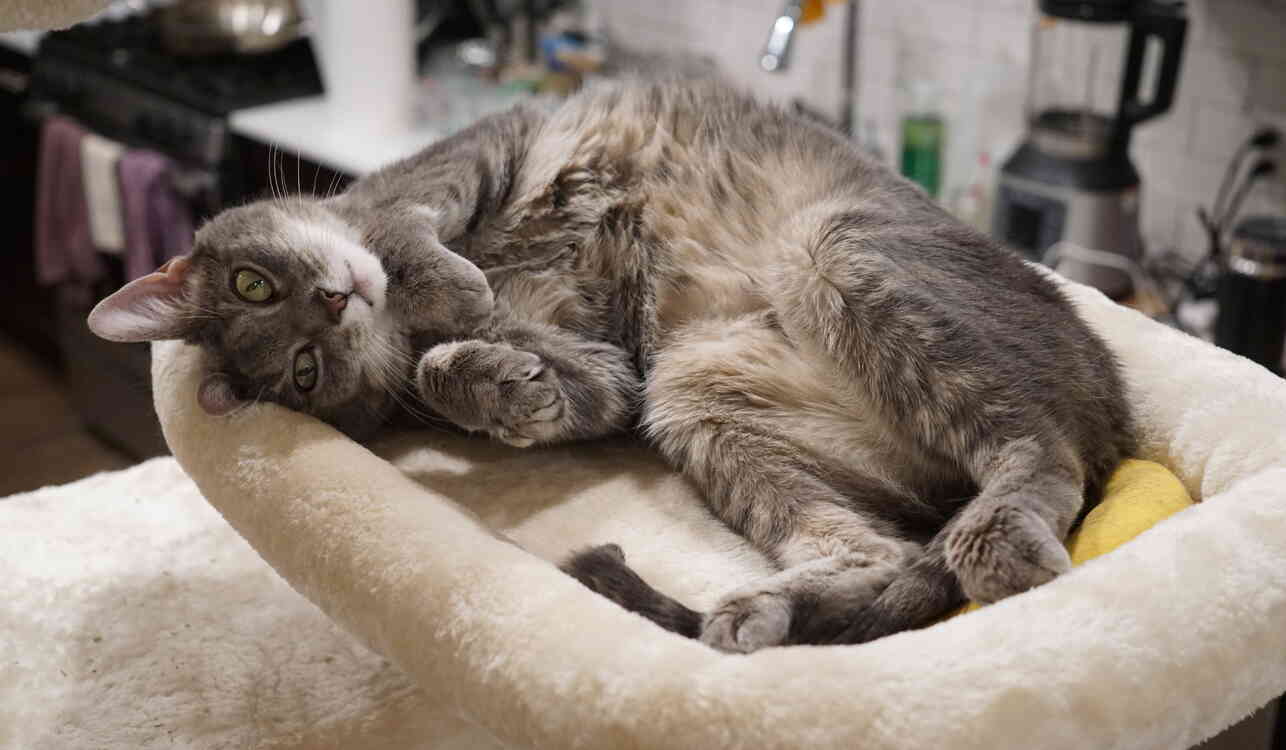
|
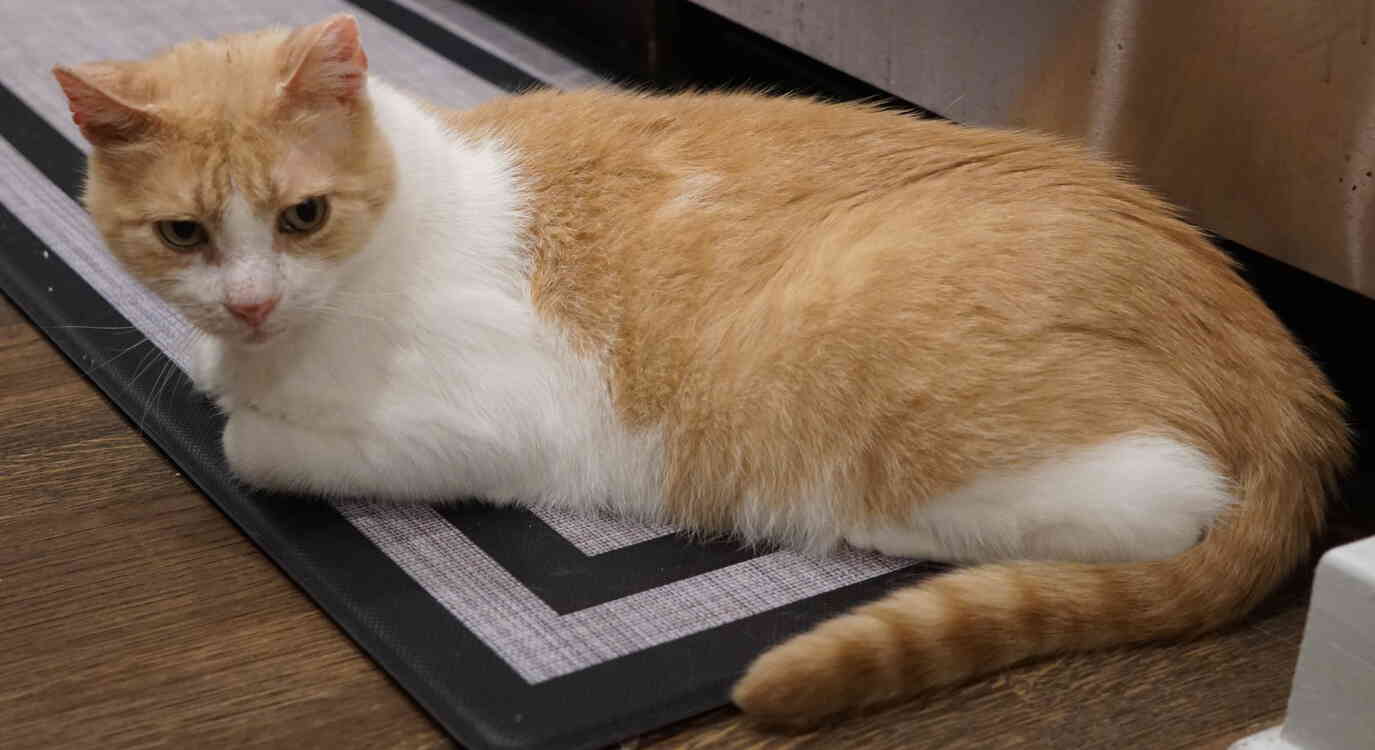
|
| Cedar |
Aspen |
Our cats have a morning routine and a similar evening routine.
In the morning, we:
- Clean Cedar's and Aspen's food dishes. Cedar's is a gray plastic one in a plastic feeder and Aspen's is an oval/elliptical metal dish.
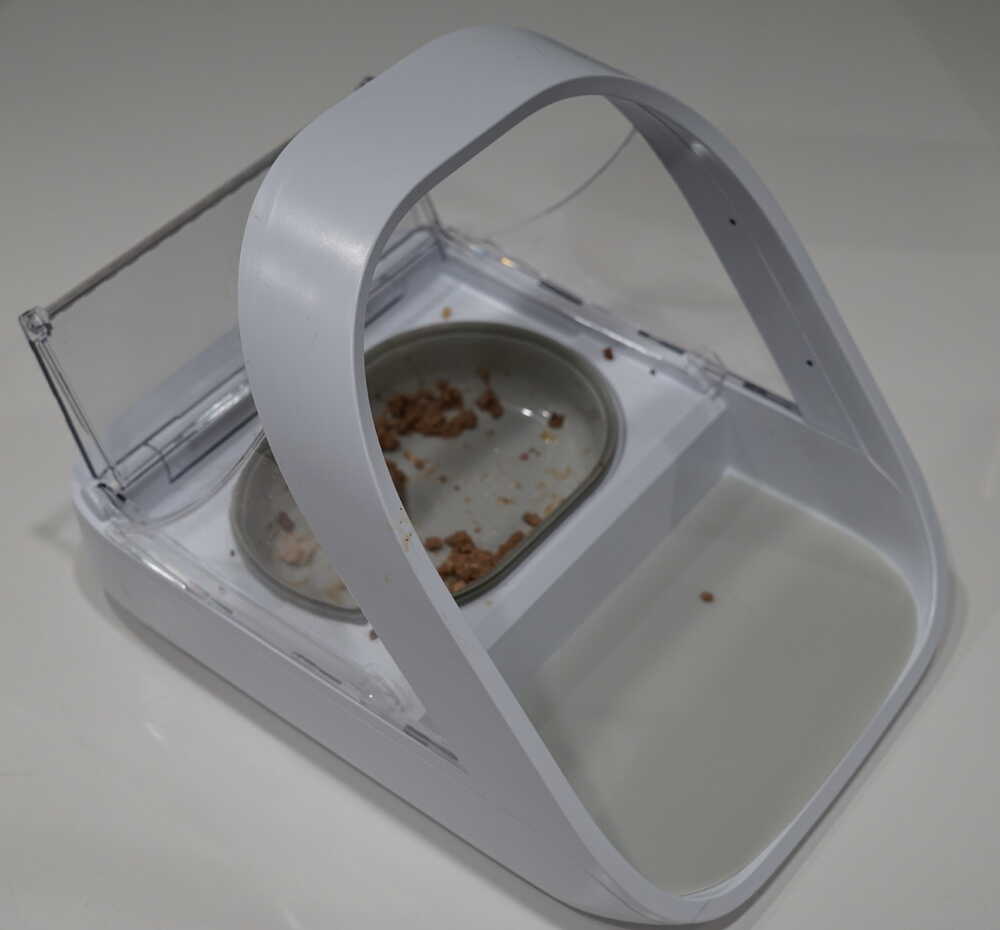
Cedar's feeder
Please use the blue sponges and dish soap by the kitchen sink.
- Serve Cedar a can of Purina "DM" diabetic cat food on the kitchen island. This is a specially-formulated wet food for her diabetes. She has a special feeder that only opens when she sticks her head into it -- it scans her microchip -- which prevents Aspen from stealing it when she isn't looking.
To open and close the feeder, press the big round button on the back. We usually pick the feeder up off the ground, put food into it, close it, and put it back where it was. Try to spread Cedar's food out in her dish so that the lid does not get soiled when it closes.
We keep two forks in a small blue bowl by the kitchen sink. Please feel free to use these to give our cats their food.
- Administer Cedar's insulin shot while she is eating. Please see the instructions below for how to administer insulin.
- Serve Aspen a full can of cat food (other than the Purina DM). We keep his dish and silicone food mat far from Cedar. Please place his food dish on the silicone food mat: He's a messy eater! Flaking or chopping the food helps him eat it -- the poor boy has few teeth.
- Change Cedar's and Aspen's water. Aspen's water bowl is by his food dish. Cedar uses a black "ApacheCon"-labeled metal cup next to her feeder. Tap water is fine.
- Clean their litterboxes. There are three:
- one in our bedroom by the door
- one in the living room; and
- one in the guest bathroom to the right of our main entrance.
We keep plastic trash bags by the boxes to hold soiled litter. Feel free to add fresh litter if the boxes get low. One of the boxes uses an even mix of Special Kitty-branded clay litter and a corn or walnut-based litter; the others use Arm & Hammer clay litter.
If the bags get heavy, please discard them in the refuse room, which is by the elevators down the hall to the right (when facing out of our home). We keep extra bags by the litterboxes.
- Spend a little time observing and maybe playing with them.
In the evening, we do the same routine as the morning one EXCEPT that we:
- Serve Cedar a can of Nulo or Weruva instead of Purina "DM" diabetic cat food.
- Spend a little more time observing and playing with them.
Cedar (the gray tabby girl) is diabetic. She requires two insulin shots a day, 12 hours apart. Without regular shots, she will die.
Administering the correct dose at regularly-spaced times is critical! In general, missing or delaying a shot is safer than receiving one too soon (before 12 hours pass). The former will cause high blood sugar, but the latter could cause hypoglycemia (dangerously low blood sugar), which is fatal.
Do not administer a shot until 12±1 hours pass since her last shot.
We maintain a paper shot log on our refrigerator door. It tracks when we gave Cedar her shots and helps us space them out properly to avoid hypoglycemia.
Each line records a single shot. It includes:
- the date of the shot (usually MM-DD format)
- the time of the shot (please note AM or PM or use 24-hour time)
- how many units of insulin we gave her; and
- anything noteworthy, such as accidentally squirting some insulin onto Cedar's skin while administering her shot, or skipping the shot because she wasn't eating.
Here are some lines from one of our log sheets:
| 04-19 | 7:18 | 5.0 |
| 04-19 | 19:10 | 5.0 |
| 04-20 | 7:04 | 5.0 |
| 04-20 | 18:59 | 5.0 |
| 04-21 | 7:05 | 5.0 |
| 04-21 | 19:05 | 5.0 |
| 04-22 | 7:05 | 5.0 |
| 04-22 | 19:04 | 5.0 |
Cedar requires 5 units of insulin per shot. We administer it using U-100 insulin needles.
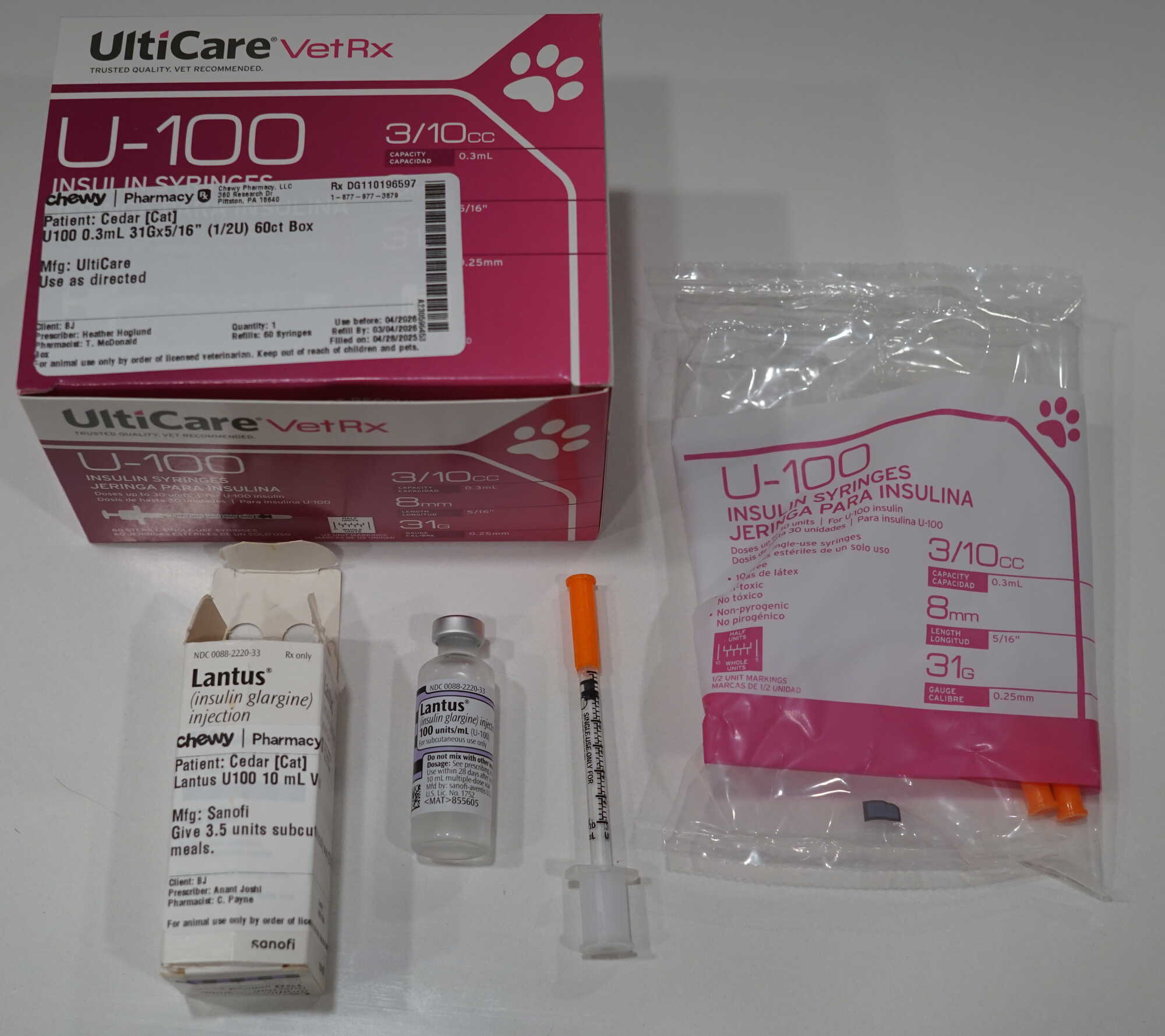
U-100 needles and Lantus insulin vial and box
To prepare the shot:
- Select a clean, unused U-100 insulin needle from the box on the kitchen island.
- Retrieve the Lantus (insulin glargine) from the refrigerator. It is a 10mL vial in a small white paper box. We keep it in the topmost refrigerator pull-out drawer.
- Uncap both needle ends.
- Insert the needle all the way into the vial's rubbery end.
- Press the plunger tightly to squeeze all the air out of the needle and into the vial.
- Slowly draw 5 units into the needle. The 5-unit line is clearly marked with a heavy line and a "5" next to it.

Please avoid air bubbles. Note that the needle might form a vacuum: Filling it with insulin could take a while. You can also slowly draw more than 5 units, then press some insulin back into the vial to get rid of bubbles.
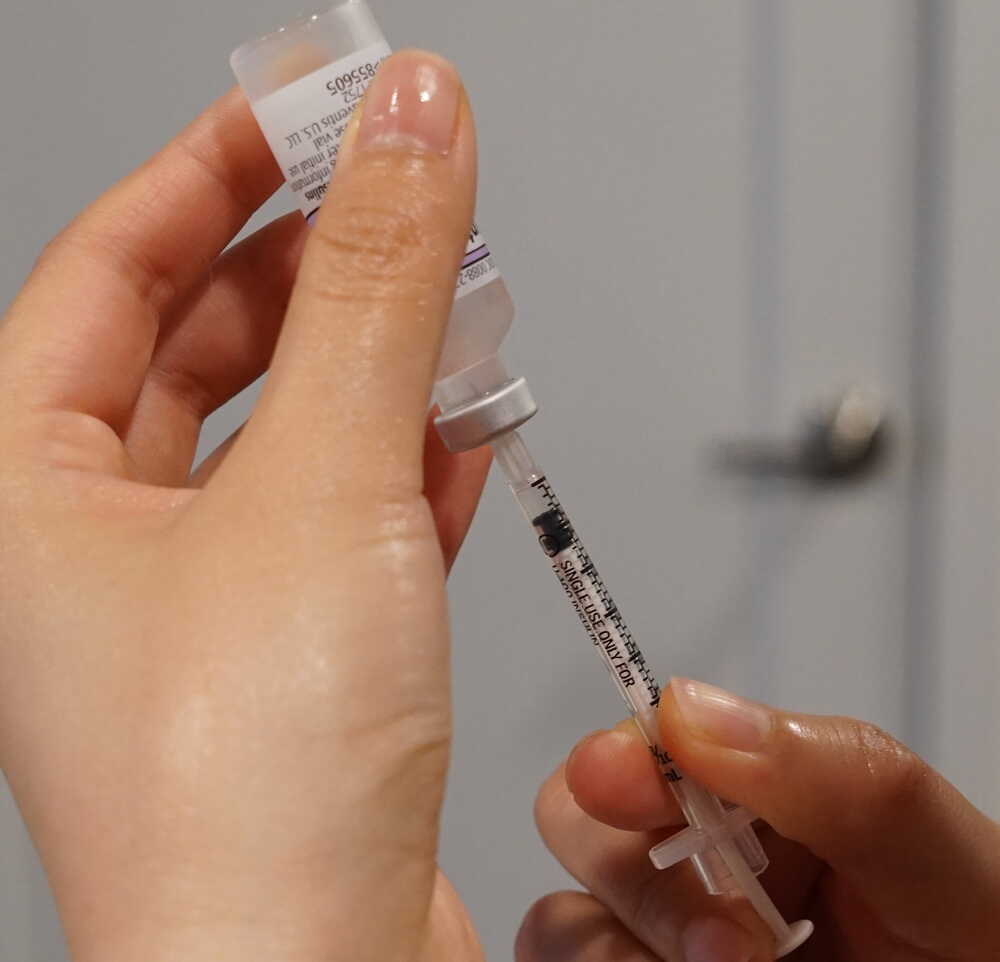
Filling an insulin needle
- Place the Lantus vial back into its box and into the refrigerator where you found it. Lantus has to remain chilled or it loses its effectiveness.
To give Cedar the shot:
- Let Cedar eat a little first. She MUST eat some food before you administer the shot, but she doesn't have to finish her meal.
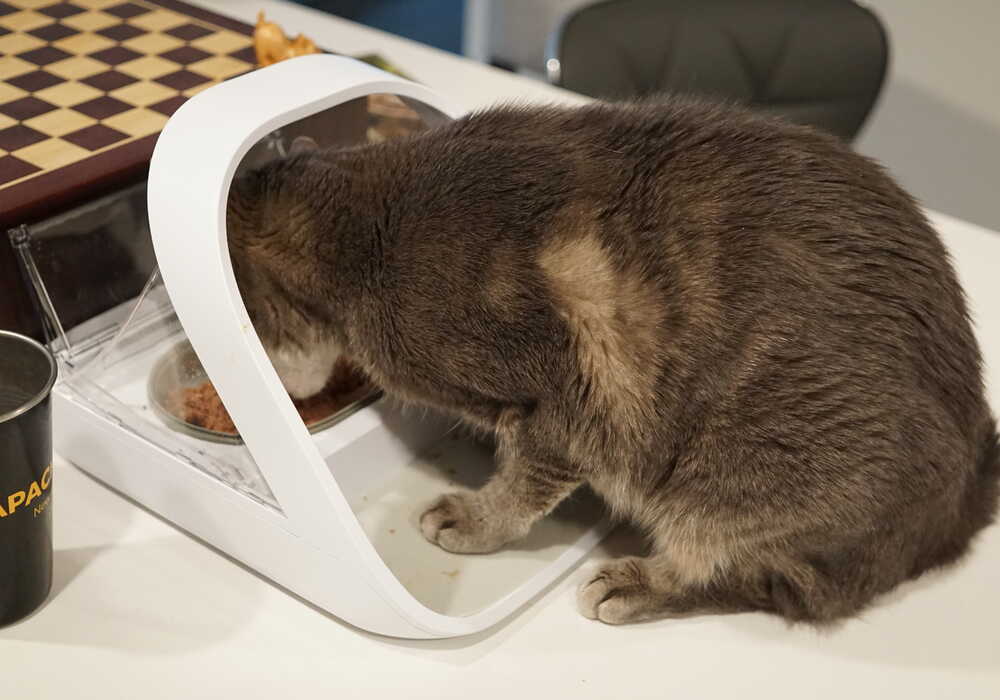
The perfect time to approach Cedar
- Slowly approach Cedar from the back or side while she is eating. She is much more cooperative if you do this calmly and without rushing. If she faces you when you're close, she might walk away; if that happens, back off, speak kindly and reassuringly to her, and let her return to her food before you try again.
- Gently but firmly pinch her scruff (the skin on the back of her neck) and pull it up and away from her body. This should form a "skin tent" with space under her skin where you can insert the needle. Once you do this, Cedar will probably stop eating and might crouch down to make your work easier, but you should proceed quickly (but carefully!) from here because she might squirm and run away after a few seconds.
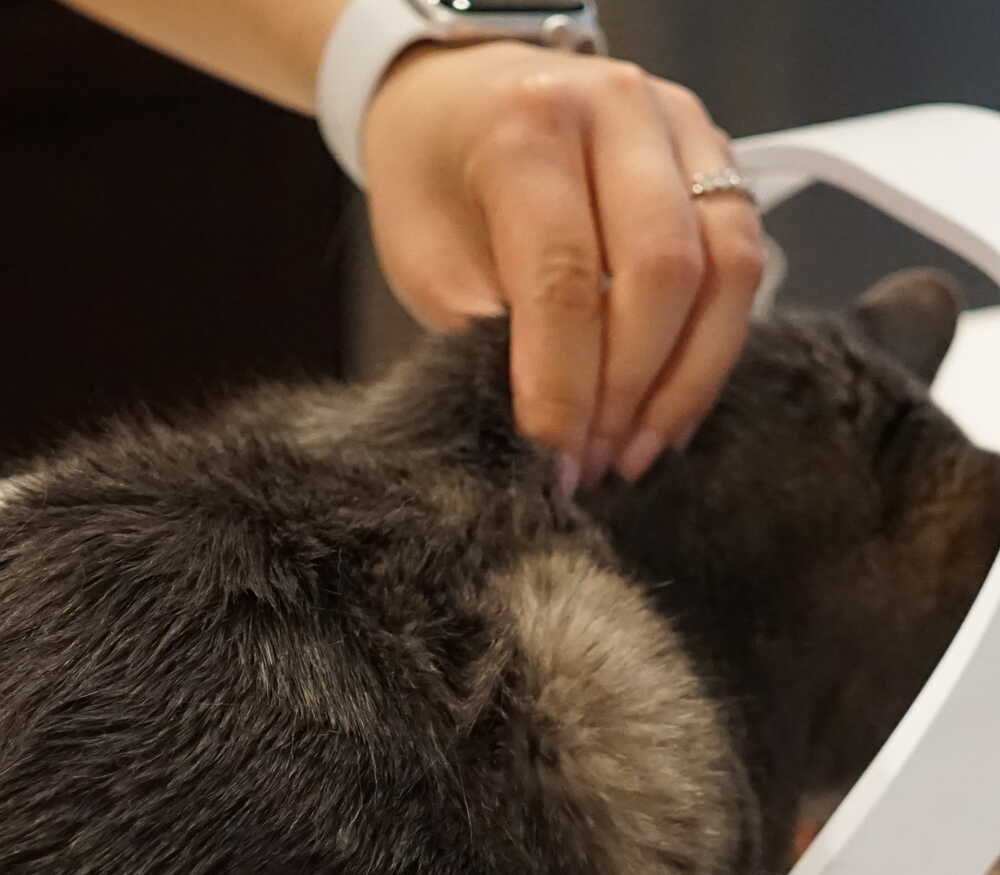
Pulling Cedar's scruff
Alternatively, you can form a skin tent using the skin between her shoulder blades, but this is more difficult.
- Insert the needle into the skin tent you formed. The goal is to get the needle under her skin, not into her muscles: It's a subcutaneous shot. DO NOT SIMPLY STICK THE NEEDLE INTO HER NECK! You don't have to insert the needle all the way, either. Make sure you don't push the needle so far that it exits her skin on the other side of the tent. Beware sticking yourself with the needle, too!
Needles pierce Cedar's skin fairly easily. You might not feel much resistance, which can give the illusion that you haven't pierced her skin at all. If in doubt, you can gently pet her neck after injecting her to see whether it's wet: If it is, you accidentally squirted insulin onto her skin. If this happens, DO NOT TRY TO CORRECT YOUR MISTAKE! Giving her more insulin to correct a mistake risks hypoglycemia.
Try to vary where you pierce Cedar's skin. Repeatedly piercing the same spot risks irritation and inflammation.
- Quickly inject the insulin. If you take too long, Cedar might pull away. If she does, you can repeat this procedure with the insulin left in the needle.
- Remove and discard the needle. Please put the used needle in the yellow-orange tin on the kitchen counter next to the refrigerator: This is our sharps box. Beware the needles already in there!
Cedar might whine or yowl when you stick the needle into her or inject the insulin. This is normal. If she squirms and tries to run while you inject her, let her do so and try again with what's left in the needle after she calms down and resumes eating.
After you've discarded the needle, please record the shot in our shot log on the refrigerator door. This will inform you (or the next person to inject Cedar) when you last administered a shot.
WARNING:
DO NOT give Cedar a shot if you do not see an entry in the shot log roughly 12 hours earlier. Maybe she received a shot 12 hours earlier, or maybe she didn't, but someone might have given her a shot much more recently and forgotten to record it. Missing a shot is safer than giving Cedar one too soon! If in doubt, skip her shot. If you know the person who should have given Cedar's earlier shot, please remind the person to record shots.
Hypoglycemia occurs when Cedar has dangerously low blood sugar. It can happen if you give her too much insulin or too soon.
Hypoglycemia is an emergency when Cedar is passed out and unresponsive to your approach and touch. If you talk with her and stroke her body (especially her lower back, which she does not like) but she does not respond, please do the following:
- Find the Karo syrup on the kitchen counter.
- Put about a spoonful of Karo syrup in her mouth. You can rub it on the inside of her lips or put it on her tongue. The syrup will quickly boost her blood sugar.
- Take her to a 24/7 emergency veterinary care center immediately.
Please feel free to use one of the several cat carriers in our home to transport our cats. We will reimburse all expenses for medical treatment.
In addition to the usual emergency situations, please take our cats to a 24/7 emergency veterinary care center if:
- Cedar is suffering a severe hypoglycemic episode.
- Either cat has not eaten or drank water in 24 hours. This is especially dire for Cedar: If she does not eat or drink, she will quickly suffer diabetic ketoacidosis (DKA), which is elevated blood acid levels. This is deadly if left untreated.
- Clark Animal Hospital (website)
- 1075 Westfield Ave, Rahway, NJ 07065 (map)
- +1 732 388 3379
- Cedar's medical records are under the last name "Vaughan". Aspen does not have medical records yet.
In a dire emergency, please take our cats to one of these 24/7 emergency care centers. From highest to lowest preference:
- Veterinary Emergency Group (website)
- 2317 U.S. 22, Union, NJ 07083 (map)
- +1 908 258 7519
- Cedar has medical records here; Aspen does not.
- Garden State Veterinary Services (website)
- 1200 Rt. 9 North, Woodbridge, NJ 07095 (map)
- +1 732 283 3535
- Neither of our cats has been here yet.
- Red Bank Veterinary Hospital (website)
- 100 Schulz Dr, Red Bank, NJ 07701 (map)
- +1 732 747 3636
- Cedar has medical records here; Aspen does not.









